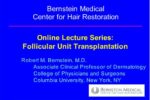Q: I have read on numerous websites that Propecia and Minoxidil work synergistically, and that a hair loss suffer will see better results using them together than either one alone. Do you believe this is the case, or do you think Propecia is enough treatment by itself for someone who just began to experience slight hair thinning and is too early for hair transplantation? — K.V., Hewlett Bay Park, New York
A: They may act synergistically since their mechanisms of action are different.
Rogaine (Minoxidil) stimulates the hair follicle directly, but Propecia (Finasteride 1 mg) permits hair growth by blocking the negative effects of DHT. Of the two, Propecia is far more effective. It is reasonable to use the two together as long as the medications are used regularly.


 Robert M. Bernstein, MD has been selected as one of New York Magazine’s “Best Doctors” for the seventh year in a row.
Robert M. Bernstein, MD has been selected as one of New York Magazine’s “Best Doctors” for the seventh year in a row. Dr. Bernstein, a renowned teacher, lecturer, and surgeon, is bringing his state-of-the-art hair restoration techniques directly to patients. His lecture on Follicular Unit Transplantation (FUT) includes a historical review of hair transplant techniques, from the out-dated “hair plugs” and “cornrows” to refined FUT procedures. Watch the lecture to see images of surgical tools, illustrations of surgical techniques, and before and after patient photos.
Dr. Bernstein, a renowned teacher, lecturer, and surgeon, is bringing his state-of-the-art hair restoration techniques directly to patients. His lecture on Follicular Unit Transplantation (FUT) includes a historical review of hair transplant techniques, from the out-dated “hair plugs” and “cornrows” to refined FUT procedures. Watch the lecture to see images of surgical tools, illustrations of surgical techniques, and before and after patient photos.


